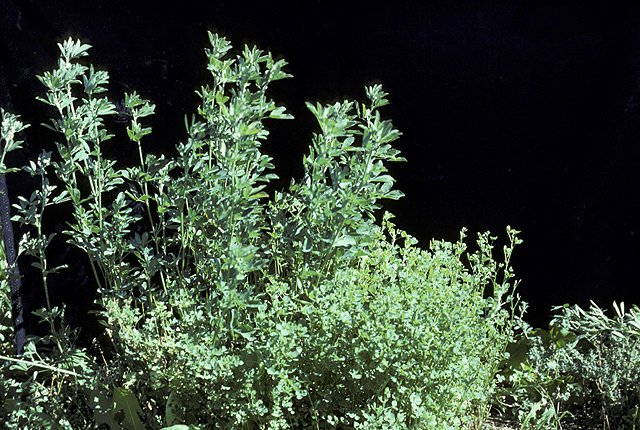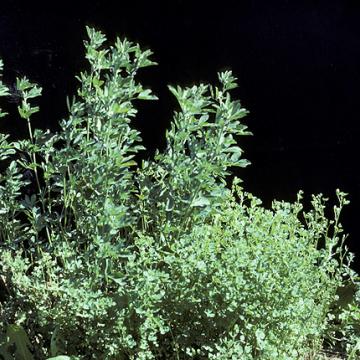DISEASE: Bacterial blight (Angular leaf spot)
HOST: Cotton
Leaf with advanced stage of blight.

Bacterial blight (Angular leaf spot) | Cotton
DISEASE: Bacterial blight (Angular leaf spot)
HOST: Cotton (Gossypium barbadense)
PATHOGEN: Xanthomonas citri subsp. malvacearum
PATHOGEN SYNONYM: Xanthomonas campestris pv. malvacearum
SOURCE: M. Shurtleff
DISEASE: Bacterial blight (Angular leaf spot)
HOST: Cotton
Highly susceptible (left) and resistant (right) cotton cultivars. The black arm stage of the disease is the most serious and occurs when bacteria invade petioles and then stems.

Bacterial blight (Angular leaf spot) | Cotton
DISEASE: Bacterial blight (Angular leaf spot)
HOST: Cotton (Gossypium barbadense)
PATHOGEN: Xanthomonas citri subsp. malvacearum
PATHOGEN SYNONYM: Xanthomonas campestris pv. malvacearum
SOURCE: APS
DISEASE: Bacterial blight (Angular leaf spot)
HOST: Cotton
Characteristic early symptoms are water-soaked leaf spots and water-soaking along veins.

Bacterial blight (Angular leaf spot) | Cotton
DISEASE: Bacterial blight (Angular leaf spot)
HOST: Cotton (Gossypium barbadense)
PATHOGEN: Xanthomonas citri subsp. malvacearum
PATHOGEN SYNONYM: Xanthomonas campestris pv. malvacearum
SOURCE: A. Hayward
DISEASE: Bacterial blight (Angular leaf spot)
HOST: Cotton
Leaf with dark, angular leaf spots. Systemic invasion causes blackening of midribs.

Bacterial blight (Angular leaf spot) | Cotton
DISEASE: Bacterial blight (Angular leaf spot)
HOST: Cotton (Gossypium barbadense)
PATHOGEN: Xanthomonas citri subsp. malvacearum
PATHOGEN SYNONYM: Xanthomonas campestris pv. malvacearum
SOURCE: APS
DISEASE: Periwinkle yellows
HOST: Periwinkle
Leaves with characteristic yellow and chlorotic appearance. Yellowing is first associated with veins.

Periwinkle yellows | Periwinkle
DISEASE: Periwinkle yellows
HOST: Periwinkle (Vinca sp.)
PATHOGEN: 'Candidatus Phytoplasma' sp.
PATHOGEN SYNONYM: Phytoplasma (undefined)
SOURCE: R. McCoy, M. Davis
DISEASE: Witches'-broom
HOST: Alfalfa
Alfalfa plant (center) exhibiting stunting and proliferation of stems. Other symptoms are small, rounded, chlorotic, often puckered leaves and a yellowish cast.

Witches'-broom | Alfalfa
DISEASE: Witches'-broom
HOST: Alfalfa (Medicago sativa)
PATHOGEN: 'Candidatus Phytoplasma trifolii'
PATHOGEN SYNONYM: Phytoplasma Clover proliferation group
SOURCE: S. Thomson
DISEASE: Witches'-broom
HOST: Alfalfa
Young plant (left) with small, numerous stems (witches'-broom). Healthy stems (right).

Witches'-broom | Alfalfa
DISEASE: Witches'-broom
HOST: Alfalfa (Medicago sativa)
PATHOGEN: 'Candidatus Phytoplasma trifolii'
PATHOGEN SYNONYM: Phytoplasma Clover proliferation group
SOURCE: S. Thomson
DISEASE: Witches'-broom
HOST: Cactus
Witches'-broom of Opuntia cactus.

Witches'-broom | Cactus
DISEASE: Witches'-broom
HOST: Cactus (Opuntia sp.)
PATHOGEN: 'Candidatus Phytoplasma' sp.
PATHOGEN SYNONYM: Phytoplasma (undefined)
SOURCE: R. McCoy, M. Davis
DISEASE: Witches'-broom
HOST: Citrus (Lime)
Lime tree with compact, small leaves (witches'-broom). Leaves on older brooms dry out and eventually drop, leaving dead, bare branches. There are no flowers or fruit on brooms.

Witches'-broom | Citrus (Lime)
DISEASE: Witches'-broom
HOST: Citrus (Lime) (Citrus sp.)
PATHOGEN: 'Candidatus Phytoplasma aurantifolia'
PATHOGEN SYNONYM: Phytoplasma Peanut witches'-broom group
SOURCE: J. Bove, M. Garnier










